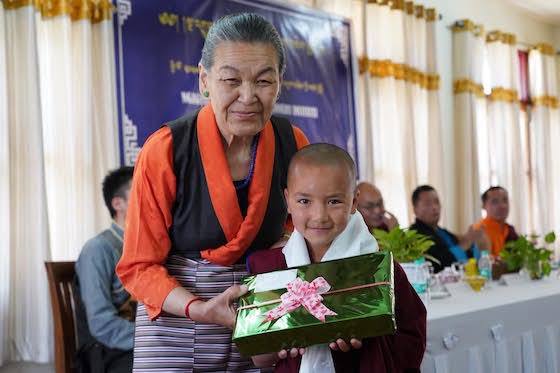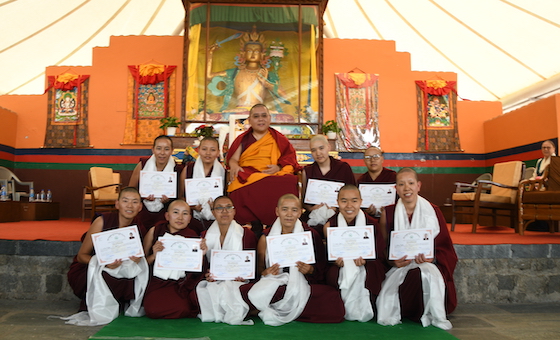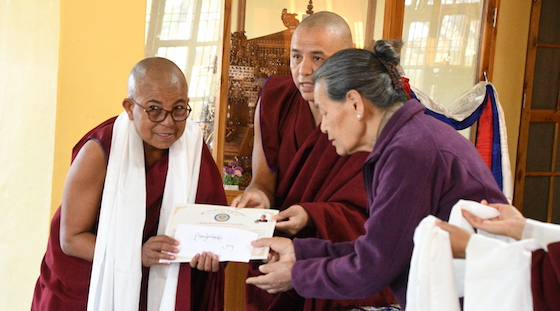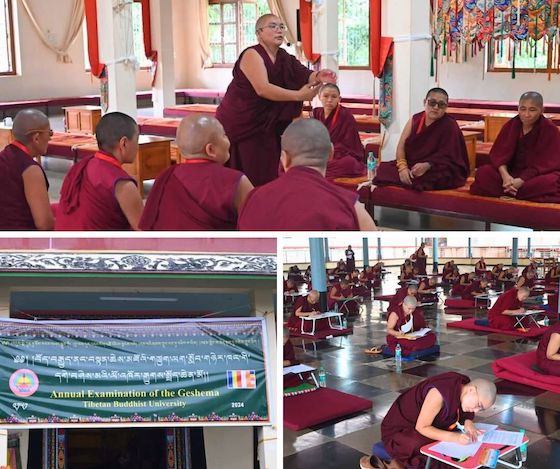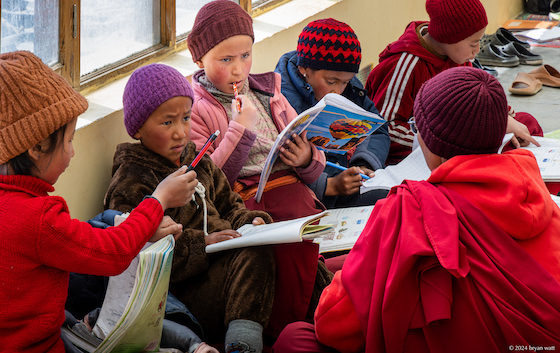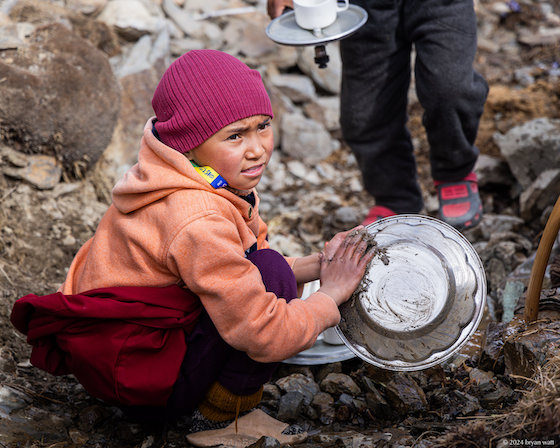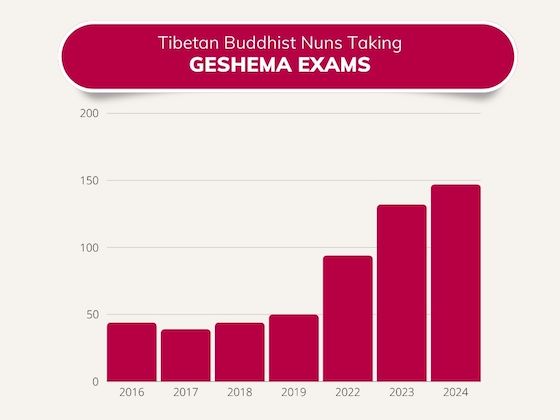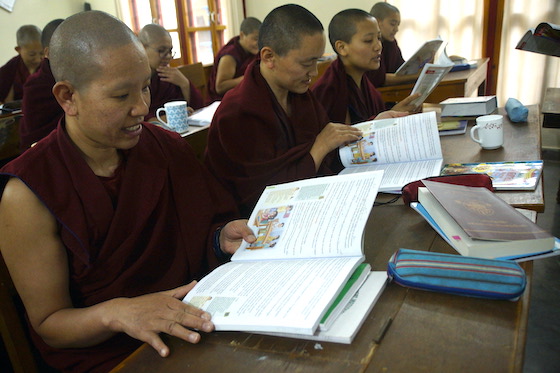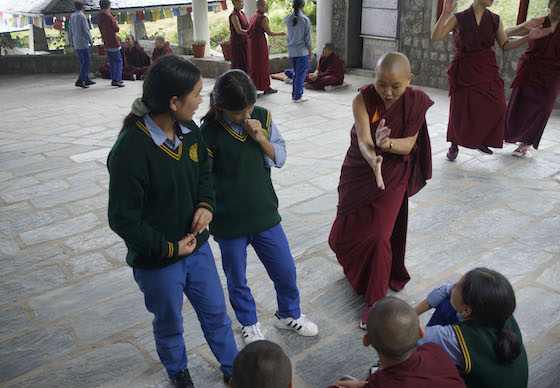Record Number of Nuns Take 2025 Geshema Exams
The 2025 Geshema exam results are in!
During the summer, a record number of Tibetan Buddhist nuns took various levels of the four-year exams for the Geshema degree. Of the 161 nuns, 154 passed. This is a 96% pass rate.
Forty-seven nuns passed their fourth and final year of exams and will formally graduate as Geshemas in November.

Rows of Tibetan Buddhist nuns taking Geshema exams in 2025. Photo by the Dolma Ling Media Nuns.
The Geshema degree is the highest level of training in the Gelug tradition and is roughly equivalent to a PhD in Tibetan Buddhist philosophy. It is the same as the Geshe degree for monks, but the ending “ma” marks it as referring to a woman. Until recently, this degree was reserved for men. It was only formally opened to women in 2012. The opening up of higher degrees for nuns is a breakthrough for Tibetan Buddhist nuns’ education.
In 2025, nuns took the exams as follows:
1st-year exams: 48 nuns, 44 passed
2nd year: 33 nuns took exams, 32 passed
3rd year: 31 nuns took exams, 31 passed
4th and final year: 49 nuns took exams, 47 passed

2025 marks another new record for nuns taking various levels of the 4-year Geshema exams. The degree was only opened to women in 2012. No exams were held in 2020 or 2021 due to COVID.
The exams were hosted this year by Dolma Ling Nunnery and Institute near Dharamsala from July 21 to August 16, 2025. The costs of the nuns’ travel, food, and the exam process were once again covered by the Tibetan Nuns Project’s Geshema Endowment Fund.
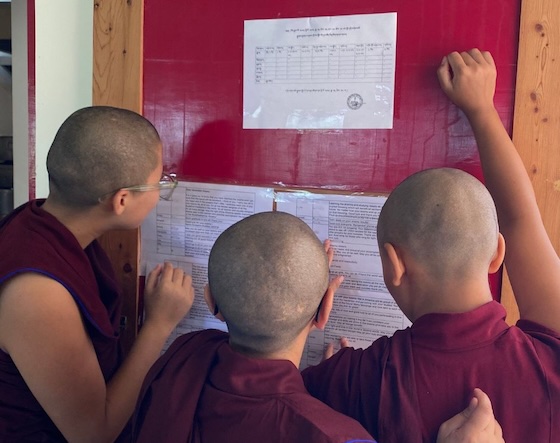
Tibetan Buddhist nuns reading messages of support for the 2025 Geshema exams. Thank you to everyone who sent good wishes to the nuns!
The nuns gathered in late June for a final, one-month study period before the start of the exams. The nuns from Kopan Nunnery in Nepal created this charming video about their journey to Dolma Ling and the final days of exam preparation. Can’t see the video? Click here.
About the Geshema Degree
The Geshema degree enables Tibetan Buddhist nuns to become teachers, leaders, and role models. It makes these dedicated women eligible to assume various leadership roles in their monastic and lay communities reserved for degree holders and hence previously not open to women.
The exams take four years to complete, with one set held each year over two weeks. Candidates are examined on the entirety of their 17-year course of study of the Five Great Canonical Texts. They must achieve a score of at least 75 per cent during their studies to be eligible to sit the exams.
TNP’s Founding Director and Special Advisor Rinchen Khando Choegyal has said, “Educating women is powerful… It’s about enabling the nuns to be teachers in their own right and to take on leadership roles at a critical time in our nation’s history.”
Here’s a video by the Dolma Ling Media Nuns about the 2025 Geshema exams. Can’t see the video? Click here.
The formal graduation ceremony for the 47 new Geshemas will take place in November after the annual inter-nunnery debate in Bodh Gaya. This will bring the total number of Geshemas to 120.
Here’s a list of the Geshema graduations since women were first allowed to take this degree in 2012:
- 2016: 20 nuns became Geshemas
- 2017: 6 nuns graduated as Geshemas
- 2018: 10 nuns became Geshemas
- 2019: 7 nuns graduated at the end of November
- 2020: exams cancelled due to the pandemic
- 2021: exams cancelled for a second year due to COVID
- 2022: 10 nuns became Geshemas
- 2023: 7 nuns graduated
- 2024: 13 nuns graduated
- 2025: 47 nuns graduating in November
The Geshemas are paving the way for other nuns to follow in their footsteps and the momentum is building. Not long ago, this increased status of nuns was almost unimaginable and we are so grateful for your support to educate and empower these dedicated women!
Thank you to everyone who sent good luck messages to the nuns this year! We gathered 74 messages from around the world and posted them at Dolma Ling for everyone to read before and during the exams.
Here’s a sample message from Scott: “Very inspired by your dedication! May your incredible effort benefit countless beings. Thank you!!” Steve wrote, “Your accomplishment brings great benefit and light to the world, at a time of darkness elsewhere. Bowing with great respect for your vision and perseverance.”
Gratitude to His Holiness the Dalai Lama
The success of the nuns would not be possible without the support and encouragement of His Holiness the Dalai Lama, patron of the Tibetan Nuns Project. As this recent article outlines, His Holiness “encouraged nuns to become advanced degree holders as part of his broader goal to increase gender parity.”
“Biologically there is no difference between the brains of men and women and the Buddha clearly gave equal rights to men and women,” His Holiness the Dalai Lama said in 2013. In 2018, he said, “In the beginning when I spoke about awarding Geshema degrees, some were doubtful. I clearly told them that Buddha had given equal opportunity for both men and women.”

Art from painting contest by Shugsep nuns as part of celebrations of Dalai Lama’s 90th birthday
Long-Term Stability
The costs associated with the annual Geshema exams are covered thanks to the 159 donors to the Geshema Endowment, including the Pema Chodron Foundation, the Pierre and Pamela Omidyar Fund of the Silicon Valley Community Foundation, the Frederick Family Foundation, and the Donaldson Charitable Trust. We are also very grateful to all those who sponsor nuns and help them on their path. More sponsors are always needed and you can learn more about sponsoring a nun here.
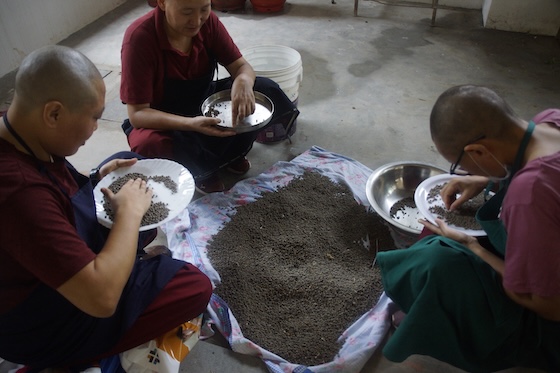
Nuns on kitchen duty sort through lentils to search for any small stones. Hosting the Geshema exams is a big enterprise with over 100 more nuns to feed for at least a 6-week period.
We would like to put more of our core programs on solid ground. By giving to the Long-Term Stability Fund, you will be helping current and future Tibetan Buddhist nuns at a critical time in Tibet’s history.
Every little bit helps! No matter what the future of Tibet holds, you can help these dedicated and courageous women to preserve their culture and spiritual traditions. Thank you!

Information session for the 2025 Geshema exams. One sponsor wrote this message of encouragement: “Your accomplishment brings great benefit and light to the world, at a time of darkness elsewhere. Bowing with great respect for your vision and perseverance.”
Thank you for your support and dedication to the Tibetan Buddhist nuns!



